My
List |
Addition Date
|
Target
|
Mission
|
Instrument
|
Size
|

|
1998-12-07 |
Europa
|
Galileo
|
Solid-State Imaging
|
453x597x1 |

|
-
PIA01643:
-
A Record of Crustal Movement on Europa
Full Resolution:
TIFF
(271.1 kB)
JPEG
(48 kB)
|

|
1998-12-07 |
Europa
|
Galileo
|
Solid-State Imaging
|
633x900x1 |

|
-
PIA01642:
-
Cracks and Ridges Distorted by Europan Fault Motion
Full Resolution:
TIFF
(161.1 kB)
JPEG
(70.66 kB)
|

|
1998-11-24 |
Europa
|
Galileo
|
Solid-State Imaging
|
1950x850x3 |

|
-
PIA01641:
-
Double Ridges, Dark Spots, and Smooth Icy Plains on Europa
Full Resolution:
TIFF
(4.186 MB)
JPEG
(582.2 kB)
|

|
1998-10-21 |
Callisto
|
Galileo
|
|
2220x1700x3 |

|
-
PIA01478:
-
Callisto Cutaway with Ocean (Artist's Concept)
Full Resolution:
TIFF
(5.246 MB)
JPEG
(490.9 kB)
|

|
1998-10-14 |
Jupiter
|
Galileo
Hubble Space Telescope
|
|
850x950x3 |

|
-
PIA01477:
-
Jupiter's White Ovals
Full Resolution:
TIFF
(648.3 kB)
JPEG
(32.09 kB)
|

|
1998-10-13 |
Europa
|
Galileo
|
Solid-State Imaging
|
747x800x1 |

|
-
PIA01640:
-
Mitten shaped region of Chaotic Terrain on Europa
Full Resolution:
TIFF
(609.5 kB)
JPEG
(177.1 kB)
|

|
1998-10-13 |
Jupiter
|
Galileo
|
Solid-State Imaging
|
592x537x3 |
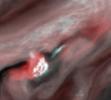
|
-
PIA01639:
-
Water Cloud Thunderstorm Northwest of Great Red Spot
Full Resolution:
TIFF
(621.9 kB)
JPEG
(19.42 kB)
|

|
1998-10-13 |
Jupiter
|
Galileo
|
Solid-State Imaging
|
1152x855x1 |

|
-
PIA01638:
-
Jovian Lightning and the Daytime Storm
Full Resolution:
TIFF
(188.1 kB)
JPEG
(89.44 kB)
|

|
1998-10-13 |
Io
|
Galileo
|
Solid-State Imaging
|
689x350x3 |

|
-
PIA01637:
-
Io's Aurorae
Full Resolution:
TIFF
(638 kB)
JPEG
(46.23 kB)
|

|
1998-10-13 |
Jupiter
|
Galileo
|
Solid-State Imaging
|
880x620x3 |

|
-
PIA01636:
-
Changing Lightning Storms on Jupiter
Full Resolution:
TIFF
(84.96 kB)
JPEG
(37.34 kB)
|

|
1998-10-13 |
Io
|
Galileo
|
Solid-State Imaging
|
1054x352x3 |

|
-
PIA01635:
-
Io in Eclipse reveals High Temperature Hot Spots
Full Resolution:
TIFF
(323.3 kB)
JPEG
(59.78 kB)
|

|
1998-10-13 |
Callisto
|
Galileo
|
Solid-State Imaging
|
6490x13101x1 |

|
-
PIA01634:
-
Asgard Multi-Ring Structure on Callisto
Full Resolution:
TIFF
(51.5 MB)
JPEG
(5.352 MB)
|

|
1998-10-13 |
Europa
|
Galileo
|
Solid-State Imaging
|
2686x2494x1 |

|
-
PIA01633:
-
The Tyre multi-ring Structure on Europa
Full Resolution:
TIFF
(6.208 MB)
JPEG
(1.347 MB)
|

|
1998-10-13 |
Callisto
|
Galileo
|
Solid-State Imaging
|
720x703x1 |

|
-
PIA01632:
-
Callisto's Varied Crater Landscape
Full Resolution:
TIFF
(395.8 kB)
JPEG
(126 kB)
|

|
1998-10-13 |
Callisto
|
Galileo
|
Solid-State Imaging
|
800x799x1 |

|
-
PIA01631:
-
So few Small Craters on Callisto
Full Resolution:
TIFF
(528.1 kB)
JPEG
(188.6 kB)
|

|
1998-10-13 |
Callisto
|
Galileo
|
Solid-State Imaging
|
1422x1252x1 |

|
-
PIA01630:
-
Callisto: Pits or Craters?
Full Resolution:
TIFF
(1.007 MB)
JPEG
(237.7 kB)
|

|
1998-10-13 |
Callisto
|
Galileo
|
|
800x799x1 |

|
-
PIA01629:
-
Textured Terrain in Callisto's Asgard Basin
Full Resolution:
TIFF
(600.1 kB)
JPEG
(189.1 kB)
|

|
1998-09-15 |
J Rings
|
Galileo
|
Solid-State Imaging
|
1800x2700x3 |

|
-
PIA01628:
-
Jupiter's Main and Gossamer Ring Structures
Full Resolution:
TIFF
(1.874 MB)
JPEG
(141.2 kB)
|

|
1998-09-15 |
J Rings
|
Galileo
|
Solid-State Imaging
|
2560x1920x3 |
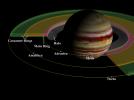
|
-
PIA01627:
-
Jupiter's Inner Satellites and Ring Components
Full Resolution:
TIFF
(2.915 MB)
JPEG
(196.2 kB)
|

|
1998-09-15 |
Io
|
Galileo
|
Solid-State Imaging
|
471x404x3 |

|
-
PIA01626:
-
Comparison of Amalthea to Io
Full Resolution:
TIFF
(159.3 kB)
JPEG
(30.32 kB)
|

|
1998-09-15 |
Amalthea
|
Galileo
|
Solid-State Imaging
|
1539x802x1 |

|
-
PIA01625:
-
Scale Comparison of the Inner Small Satellites of Jupiter
Full Resolution:
TIFF
(99.39 kB)
JPEG
(38.67 kB)
|

|
1998-09-15 |
Amalthea
|
Galileo
|
Solid-State Imaging
|
1539x1066x1 |

|
-
PIA01624:
-
Shapes of the Small Inner Satellites of Jupiter
Full Resolution:
TIFF
(163.2 kB)
JPEG
(67.18 kB)
|

|
1998-09-15 |
J Rings
|
Galileo
|
Solid-State Imaging
|
2016x1529x3 |

|
-
PIA01623:
-
Jupiter's Gossamer Ring Structure
Full Resolution:
TIFF
(942.3 kB)
JPEG
(176.7 kB)
|

|
1998-09-15 |
J Rings
|
Galileo
|
Solid-State Imaging
|
1078x636x1 |

|
-
PIA01622:
-
Jupiter's Main Ring and Halo
Full Resolution:
TIFF
(299.6 kB)
JPEG
(62.45 kB)
|

|
1998-09-15 |
J Rings
|
Galileo
|
Solid-State Imaging
|
2663x1418x1 |

|
-
PIA01621:
-
Jupiter's Ring System
Full Resolution:
TIFF
(145.1 kB)
JPEG
(62.26 kB)
|

|
1998-08-03 |
Ganymede
|
Galileo
|
Solid-State Imaging
|
800x800x3 |

|
-
PIA00716:
-
Ganymede Color Global
Full Resolution:
TIFF
(1.121 MB)
JPEG
(46.44 kB)
|

|
1998-07-15 |
Ganymede
|
Galileo
|
Solid-State Imaging
|
790x1413x1 |

|
-
PIA01606:
-
Completing a Global Map of Ganymede
Full Resolution:
TIFF
(763.1 kB)
JPEG
(129.1 kB)
|

|
1998-07-15 |
Ganymede
|
Galileo
|
Solid-State Imaging
|
900x600x1 |

|
-
PIA01620:
-
Perspective View of Bright Ridges in Uruk Sulcus
Full Resolution:
TIFF
(401.7 kB)
JPEG
(63.04 kB)
|

|
1998-07-15 |
Ganymede
|
Galileo
|
Solid-State Imaging
|
782x784x1 |

|
-
PIA01619:
-
Morning in Tiamat Sulcus
Full Resolution:
TIFF
(611.1 kB)
JPEG
(205.8 kB)
|

|
1998-07-15 |
Ganymede
|
Galileo
|
Solid-State Imaging
|
706x551x1 |

|
-
PIA01618:
-
Regional View of Ganymede
Full Resolution:
TIFF
(379.8 kB)
JPEG
(91.26 kB)
|

|
1998-07-15 |
Ganymede
|
Galileo
|
Solid-State Imaging
|
797x798x1 |

|
-
PIA01617:
-
Marius Regio, Ganymede
Full Resolution:
TIFF
(559.4 kB)
JPEG
(199.5 kB)
|

|
1998-07-15 |
Ganymede
|
Galileo
|
Solid-State Imaging
|
506x360x1 |

|
-
PIA01616:
-
Highly Fractured Dark and Bright Terrain
Full Resolution:
TIFF
(172.8 kB)
JPEG
(56.59 kB)
|

|
1998-07-15 |
Ganymede
|
Galileo
|
Solid-State Imaging
|
949x559x1 |

|
-
PIA01615:
-
Swaths of Grooved Terrain on Ganymede
Full Resolution:
TIFF
(499.9 kB)
JPEG
(160.6 kB)
|

|
1998-07-15 |
Ganymede
|
Galileo
|
Solid-State Imaging
|
531x361x1 |

|
-
PIA01614:
-
"Calderas" on Ganymede?
Full Resolution:
TIFF
(204.8 kB)
JPEG
(55.26 kB)
|

|
1998-07-15 |
Ganymede
|
Galileo
|
Solid-State Imaging
|
800x798x1 |
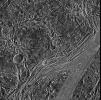
|
-
PIA01613:
-
Fractures in Nicholson Regio
Full Resolution:
TIFF
(626.8 kB)
JPEG
(202.1 kB)
|

|
1998-07-15 |
Ganymede
|
Galileo
|
Solid-State Imaging
|
615x519x1 |
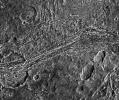
|
-
PIA01612:
-
A Tumultuous Past for Ganymede's Dark Terrain
Full Resolution:
TIFF
(293 kB)
JPEG
(99.24 kB)
|

|
1998-07-15 |
Ganymede
|
Galileo
|
Solid-State Imaging
|
692x480x3 |

|
-
PIA01611:
-
Kittu Dark Ray Crater
Full Resolution:
TIFF
(664.6 kB)
JPEG
(97.1 kB)
|

|
1998-07-15 |
Ganymede
|
Galileo
|
Solid-State Imaging
|
392x398x1 |

|
-
PIA01610:
-
Anatomy of a Torn Comet
Full Resolution:
TIFF
(168.6 kB)
JPEG
(54 kB)
|

|
1998-07-15 |
Ganymede
|
Galileo
|
Solid-State Imaging
|
813x753x1 |

|
-
PIA01609:
-
Fresh Impact Craters on Ganymede
Full Resolution:
TIFF
(576.4 kB)
JPEG
(196.4 kB)
|

|
1998-07-15 |
Ganymede
|
Galileo
|
Solid-State Imaging
|
707x1049x1 |

|
-
PIA01608:
-
High Latitude "Bright" and "Dark" Terrains on Ganymede
Full Resolution:
TIFF
(534 kB)
JPEG
(95.77 kB)
|

|
1998-07-15 |
Ganymede
|
Galileo
|
Solid-State Imaging
|
392x398x1 |

|
-
PIA01607:
-
Dark-floored Impact Craters on Ganymede
Full Resolution:
TIFF
(189.6 kB)
JPEG
(60.53 kB)
|

|
1998-07-02 |
Io
|
Galileo
|
|
800x800x1 |

|
-
PIA01605:
-
Io imaging during Galileo's 24th orbit
Full Resolution:
TIFF
(512 kB)
JPEG
(91.06 kB)
|

|
1998-07-02 |
Io
|
Galileo
|
Solid-State Imaging
|
581x900x3 |

|
-
PIA01604:
-
Close-up color view of Io
Full Resolution:
TIFF
(1.769 MB)
JPEG
(78.57 kB)
|

|
1998-06-17 |
Europa
|
Galileo
|
Near Infrared Mapping Spectrometer
|
820x470x1 |

|
-
PIA00840:
-
Infrared Observations of Europa's Trailing Side
Full Resolution:
TIFF
(94.4 kB)
JPEG
(29.74 kB)
|

|
1998-06-10 |
Jupiter
|
Galileo
|
Solid-State Imaging
|
900x900x3 |

|
-
PIA01603:
-
Time Series of Jupiter's Aurora
Full Resolution:
TIFF
(820.7 kB)
JPEG
(73.32 kB)
|

|
1998-06-10 |
Jupiter
|
Galileo
|
Solid-State Imaging
|
900x950x3 |

|
-
PIA01602:
-
Time Series of Jupiter's Aurora
Full Resolution:
TIFF
(1.121 MB)
JPEG
(91.86 kB)
|

|
1998-06-10 |
Jupiter
|
Galileo
|
Solid-State Imaging
|
900x950x3 |

|
-
PIA01601:
-
Time Series of Jupiter's Aurora
Full Resolution:
TIFF
(976.6 kB)
JPEG
(83.63 kB)
|

|
1998-06-10 |
Jupiter
|
Galileo
|
Solid-State Imaging
|
900x900x3 |
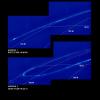
|
-
PIA01600:
-
Time Series of Jupiter's Aurora
Full Resolution:
TIFF
(773.5 kB)
JPEG
(61.78 kB)
|

|
1998-05-21 |
Europa
|
Galileo
|
Solid-State Imaging
|
3500x2220x1 |

|
-
PIA01403:
-
A Closer Look at Chaos on Europa
Full Resolution:
TIFF
(7.139 MB)
JPEG
(1.036 MB)
|

|
1998-05-21 |
Europa
|
Galileo
|
Solid-State Imaging
|
4000x2024x1 |

|
-
PIA01407:
-
Europa Imaging Highlights During GEM
Full Resolution:
TIFF
(6.84 MB)
JPEG
(791.3 kB)
|

|
1998-05-21 |
Europa
|
Galileo
|
Solid-State Imaging
|
856x407x3 |
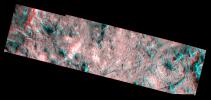
|
-
PIA01406:
-
Topography within Europa's Mannann'an Crater
Full Resolution:
TIFF
(405.7 kB)
JPEG
(51.08 kB)
|

|
1998-05-21 |
Europa
|
Galileo
|
Solid-State Imaging
|
814x560x1 |
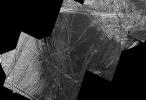
|
-
PIA01405:
-
A Dark Spot on Europa
Full Resolution:
TIFF
(353.3 kB)
JPEG
(116.1 kB)
|

|
1998-05-21 |
Europa
|
Galileo
|
Solid-State Imaging
|
800x400x1 |

|
-
PIA01404:
-
Small Craters on Europa
Full Resolution:
TIFF
(305.6 kB)
JPEG
(70.33 kB)
|

|
1998-05-21 |
Europa
|
Galileo
|
Solid-State Imaging
|
1042x643x3 |

|
-
PIA01402:
-
Mannann'an Crater
Full Resolution:
TIFF
(647.6 kB)
JPEG
(51.43 kB)
|

|
1998-05-21 |
Europa
|
Galileo
|
Solid-State Imaging
|
2700x2200x1 |

|
-
PIA01401:
-
Scrambled Ice
Full Resolution:
TIFF
(3.565 MB)
JPEG
(653.9 kB)
|

|
1998-05-08 |
Europa
|
Galileo
|
Solid-State Imaging
|
2605x3073x1 |

|
-
PIA01084:
-
Flow-like Features On Europa
Full Resolution:
TIFF
(4.78 MB)
JPEG
(471.9 kB)
|

|
1998-05-08 |
Europa
|
Galileo
|
Solid-State Imaging
|
2150x1950x1 |

|
-
PIA01092:
-
Geologic Evidence of Internal Activity on Europa
Full Resolution:
TIFF
(3.502 MB)
JPEG
(689.3 kB)
|

|
1998-05-08 |
Io
|
Galileo
|
Solid-State Imaging
|
1927x619x3 |

|
-
PIA01400:
-
The Galilean Satellites
Full Resolution:
TIFF
(2.237 MB)
JPEG
(134.9 kB)
|

|
1998-05-08 |
Io
|
Galileo
|
Solid-State Imaging
|
1870x635x3 |

|
-
PIA01299:
-
The Galilean Satellites
Full Resolution:
TIFF
(2.132 MB)
JPEG
(156.4 kB)
|

|
1998-05-08 |
Callisto
|
Galileo
|
Solid-State Imaging
|
749x344x3 |

|
-
PIA01298:
-
Global Color Variations on Callisto
Full Resolution:
TIFF
(641.4 kB)
JPEG
(39.18 kB)
|

|
1998-05-08 |
Callisto
|
Galileo
|
Solid-State Imaging
|
930x550x3 |

|
-
PIA01297:
-
View of Callisto at Increasing Resolutions
Full Resolution:
TIFF
(891.9 kB)
JPEG
(115 kB)
|

|
1998-05-08 |
Europa
|
Galileo
|
Solid-State Imaging
|
1092x1428x3 |

|
-
PIA01296:
-
Europa "Ice Rafts" in Local and Color Context
Full Resolution:
TIFF
(4.688 MB)
JPEG
(435.7 kB)
|

|
1998-05-08 |
Europa
|
Galileo
|
Solid-State Imaging
|
520x260x3 |

|
-
PIA01295:
-
Europa Global Views in Natural and Enhanced Colors
Full Resolution:
TIFF
(346.7 kB)
JPEG
(20.27 kB)
|

|
1998-04-02 |
Jupiter
|
Galileo
|
Photopolarimeter-Radiometer
|
429x585x3 |

|
-
PIA01234:
-
PPR Great Red Spot Temperature Map
Full Resolution:
TIFF
(65.49 kB)
JPEG
(30.68 kB)
|

|
1998-04-02 |
Jupiter
|
Galileo
|
Photopolarimeter-Radiometer
|
468x604x3 |

|
-
PIA01233:
-
Photopolarimeter/Radiometer (PPR) Temperature Map of Great Red Spot
Full Resolution:
TIFF
(340.9 kB)
JPEG
(32.65 kB)
|

|
1998-04-02 |
Ganymede
|
Galileo
|
Photopolarimeter-Radiometer
|
432x540x3 |

|
-
PIA01232:
-
Temperature Map of Ganymede
Full Resolution:
TIFF
(422.9 kB)
JPEG
(29.2 kB)
|

|
1998-03-26 |
Europa
|
Galileo
|
Solid-State Imaging
|
1000x800x1 |

|
-
PIA00849:
-
Ridges and Fractures on Europa
Full Resolution:
TIFF
(830.4 kB)
JPEG
(125.8 kB)
|

|
1998-03-26 |
Io
|
Galileo
|
Near Infrared Mapping Spectrometer
|
1525x1100x1 |

|
-
PIA00835:
-
NIMS Observation of Hotspots on Io
Full Resolution:
TIFF
(178 kB)
JPEG
(74.71 kB)
|

|
1998-03-26 |
Io
|
Galileo
|
Solid-State Imaging
|
1500x1000x3 |

|
-
PIA00739:
-
Eclipse Images of Io (3 views)
Full Resolution:
TIFF
(1.486 MB)
JPEG
(218.7 kB)
|

|
1998-03-26 |
Europa
|
Galileo
|
Near Infrared Mapping Spectrometer
|
1279x676x3 |

|
-
PIA00834:
-
NIMS G1 Observation of Europa
Full Resolution:
TIFF
(537.6 kB)
JPEG
(80.6 kB)
|

|
1998-03-26 |
Jupiter
|
Galileo
|
Solid-State Imaging
|
1200x700x1 |

|
-
PIA00831:
-
Mosaic of Jupiter's Great Red Spot (Violet Filter)
Full Resolution:
TIFF
(321.7 kB)
JPEG
(53.04 kB)
|

|
1998-03-26 |
Jupiter
|
Galileo
|
Solid-State Imaging
|
1000x1200x1 |

|
-
PIA01229:
-
Jupiter's Southern Hemisphere in the Near-Infrared (Time Set 3)
Full Resolution:
TIFF
(648.6 kB)
JPEG
(109.9 kB)
|

|
1998-03-26 |
Jupiter
|
Galileo
|
Solid-State Imaging
|
1000x1200x1 |

|
-
PIA01228:
-
Jupiter's Southern Hemisphere in the Near-Infrared (Time Set 2)
Full Resolution:
TIFF
(721.3 kB)
JPEG
(128.5 kB)
|

|
1998-03-26 |
Jupiter
|
Galileo
|
Solid-State Imaging
|
1200x1600x1 |

|
-
PIA01227:
-
Jupiter's Southern Hemisphere in the Near-Infrared (Time Set 1)
Full Resolution:
TIFF
(903.4 kB)
JPEG
(147.8 kB)
|

|
1998-03-26 |
Callisto
|
Galileo
|
Solid-State Imaging
|
3600x3320x1 |

|
-
PIA01054:
-
Har Crater on Callisto
Full Resolution:
TIFF
(5.217 MB)
JPEG
(1.259 MB)
|

|
1998-03-26 |
Io
|
Galileo
|
Solid-State Imaging
|
1124x712x3 |

|
-
PIA00744:
-
Arizona-sized Io Eruption
Full Resolution:
TIFF
(2.063 MB)
JPEG
(65.17 kB)
|

|
1998-03-26 |
Europa
|
Galileo
|
Solid-State Imaging
|
2000x1350x3 |

|
-
PIA00746:
-
Various Landscapes and Features on Europa
Full Resolution:
TIFF
(3.904 MB)
JPEG
(570.9 kB)
|

|
1998-03-26 |
Io
|
Galileo
|
Near Infrared Mapping Spectrometer
|
1225x935x3 |

|
-
PIA01226:
-
Two New Hot Spots on Io
Full Resolution:
TIFF
(307.3 kB)
JPEG
(67.14 kB)
|

|
1998-03-26 |
Callisto
|
Galileo
|
Solid-State Imaging
|
1450x700x1 |

|
-
PIA01225:
-
Craters in a Newly Imaged Area on Callisto
Full Resolution:
TIFF
(361.7 kB)
JPEG
(86.58 kB)
|

|
1998-03-26 |
Jupiter
|
Galileo
|
Near Infrared Mapping Spectrometer
|
712x725x3 |

|
-
PIA01224:
-
NIMS Observes the Structure and Composition of Jupiter's Clouds
Full Resolution:
TIFF
(33.81 kB)
JPEG
(75.03 kB)
|

|
1998-03-26 |
Callisto
|
Galileo
|
Solid-State Imaging
|
1691x2231x1 |

|
-
PIA00745:
-
Callisto's Equatorial Region
Full Resolution:
TIFF
(3.017 MB)
JPEG
(580.1 kB)
|

|
1998-03-26 |
Io
|
Galileo
|
Solid-State Imaging
|
646x646x3 |

|
-
PIA01223:
-
Changes on Io's Loki-Pele hemisphere
Full Resolution:
TIFF
(1.15 MB)
JPEG
(38.67 kB)
|

|
1998-03-26 |
Io
|
Galileo
|
Solid-State Imaging
|
598x641x3 |

|
-
PIA00738:
-
Topography and Volcanoes on Io (color)
Full Resolution:
TIFF
(1.08 MB)
JPEG
(47.47 kB)
|

|
1998-03-26 |
Io
|
Galileo
|
Near Infrared Mapping Spectrometer
|
2200x1700x3 |

|
-
PIA00899:
-
New Hot Spot on Io Discovered by NIMS During Orbit C9
Full Resolution:
TIFF
(783.9 kB)
JPEG
(130.5 kB)
|

|
1998-03-26 |
Callisto
|
Galileo
|
Solid-State Imaging
|
2170x1788x1 |

|
-
PIA00898:
-
Moderate-resolution view of Callisto's surface
Full Resolution:
TIFF
(866.9 kB)
JPEG
(218.5 kB)
|

|
1998-03-26 |
Jupiter
|
Galileo
|
Solid-State Imaging
|
900x1600x3 |

|
-
PIA00897:
-
Jupiter's Northern Hemisphere in False Color (Time Set 3)
Full Resolution:
TIFF
(1.178 MB)
JPEG
(55.91 kB)
|

|
1998-03-26 |
Jupiter
|
Galileo
|
Solid-State Imaging
|
900x1600x3 |

|
-
PIA00896:
-
Jupiter's Northern Hemisphere in True Color (Time Set 3)
Full Resolution:
TIFF
(975.8 kB)
JPEG
(50.84 kB)
|

|
1998-03-26 |
Jupiter
|
Galileo
|
Solid-State Imaging
|
1200x1500x3 |

|
-
PIA00895:
-
Jupiter's Northern Hemisphere in False Color (Time Set 2)
Full Resolution:
TIFF
(3.156 MB)
JPEG
(134.4 kB)
|

|
1998-03-26 |
Jupiter
|
Galileo
|
Solid-State Imaging
|
1200x1500x3 |

|
-
PIA00894:
-
Jupiter's Northern Hemisphere in True Color (Time Set 2)
Full Resolution:
TIFF
(2.027 MB)
JPEG
(84.82 kB)
|

|
1998-03-26 |
Jupiter
|
Galileo
|
Solid-State Imaging
|
900x1500x3 |

|
-
PIA00893:
-
Jupiter's Northern Hemisphere in False Color (Time Set 1)
Full Resolution:
TIFF
(2.966 MB)
JPEG
(123.3 kB)
|

|
1998-03-26 |
Jupiter
|
Galileo
|
Solid-State Imaging
|
900x1500x3 |

|
-
PIA00892:
-
Jupiter's Northern Hemisphere in True Color (Time Set 1)
Full Resolution:
TIFF
(1.889 MB)
JPEG
(71.61 kB)
|

|
1998-03-26 |
Jupiter
|
Galileo
|
Solid-State Imaging
|
900x1600x1 |

|
-
PIA00890:
-
Jupiter's Northern Hemisphere in Violet Light (Time Set 3)
Full Resolution:
TIFF
(225 kB)
JPEG
(45.94 kB)
|

|
1998-03-26 |
Jupiter
|
Galileo
|
Solid-State Imaging
|
900x1600x1 |

|
-
PIA00889:
-
Jupiter's Northern Hemisphere in a Methane Band (Time Set 3)
Full Resolution:
TIFF
(325 kB)
JPEG
(47.42 kB)
|

|
1998-03-26 |
Jupiter
|
Galileo
|
Solid-State Imaging
|
900x1600x1 |

|
-
PIA00888:
-
Jupiter's Northern Hemisphere in a Methane Band (Time Set 3)
Full Resolution:
TIFF
(323.8 kB)
JPEG
(44.62 kB)
|

|
1998-03-26 |
Jupiter
|
Galileo
|
Solid-State Imaging
|
900x1600x1 |

|
-
PIA00887:
-
Jupiter's Northern Hemisphere in the Near-Infrared (Time Set 3)
Full Resolution:
TIFF
(350.8 kB)
JPEG
(54.2 kB)
|

|
1998-03-26 |
Jupiter
|
Galileo
|
Solid-State Imaging
|
1200x1500x1 |

|
-
PIA00886:
-
Jupiter's Northern Hemisphere in Violet Light (Time Set 2)
Full Resolution:
TIFF
(452.3 kB)
JPEG
(86.06 kB)
|

|
1998-03-26 |
Jupiter
|
Galileo
|
Solid-State Imaging
|
1200x1500x1 |

|
-
PIA00885:
-
Jupiter's Northern Hemisphere in a Methane Band (Time Set 2)
Full Resolution:
TIFF
(851.4 kB)
JPEG
(138.4 kB)
|

|
1998-03-26 |
Jupiter
|
Galileo
|
Solid-State Imaging
|
1200x1500x1 |

|
-
PIA00884:
-
Jupiter's Northern Hemisphere in a Methane Band (Time Set 2)
Full Resolution:
TIFF
(844 kB)
JPEG
(119.9 kB)
|

|
1998-03-26 |
Jupiter
|
Galileo
|
Solid-State Imaging
|
1200x1500x1 |

|
-
PIA00883:
-
Jupiter's Northern Hemisphere in the Near-Infrared (Time Set 2)
Full Resolution:
TIFF
(853.9 kB)
JPEG
(127.7 kB)
|

|
1998-03-26 |
Jupiter
|
Galileo
|
Solid-State Imaging
|
900x1500x1 |

|
-
PIA00882:
-
Jupiter's Northern Hemisphere in Violet Light (Time Set 1)
Full Resolution:
TIFF
(433.5 kB)
JPEG
(44.84 kB)
|

 Planetary Data System
Planetary Data System





















































































































